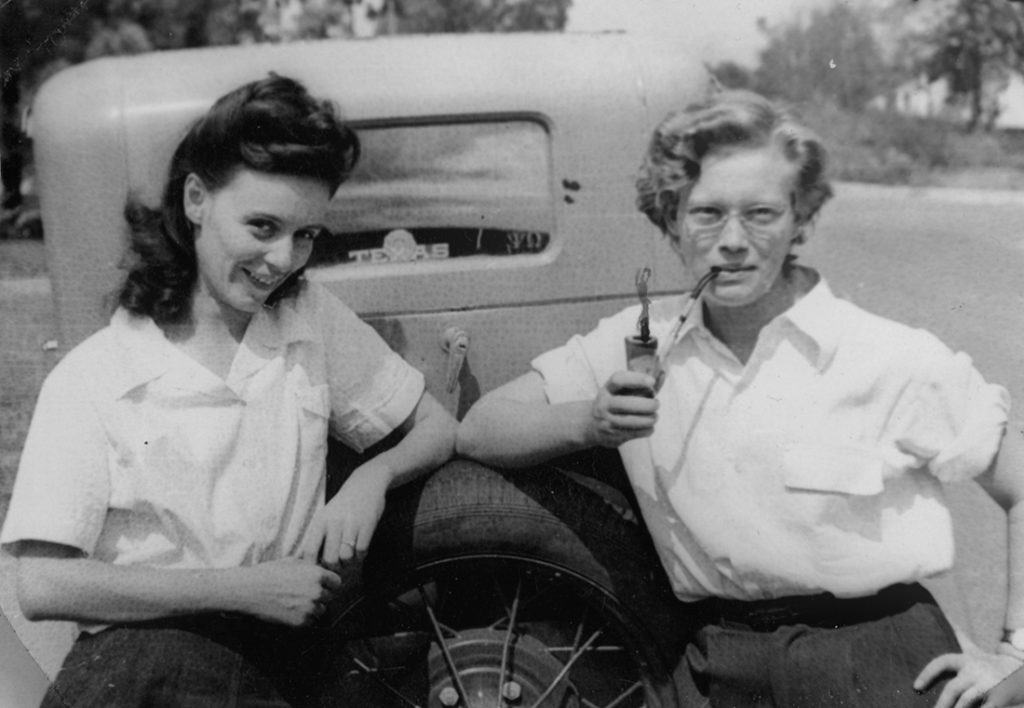
A 54-Year Romance
Prominent artist and pediatrician first met at University of Houston in 1946.

When friends and relatives speak of Pat Gustavson and her partner, Mignon Weisinger, they describe the lesbian couple as self-sufficient, talented, outgoing, compassionate, and generous. The two professional women, who were deeply attached to each other, enjoyed a 54-year relationship that ran from 1946 until 2001.
Gustavson was a skilled pediatrician who specialized in premature babies, and Weisinger was a talented artist. They both spent much of their adult lives as teachers—Gustavson at the University of Texas Medical Branch at Galveston, and Weisinger at schools in Houston and Galveston.
Their long relationship ended when Weisinger died from cancer in 2001. Gustavson lived until 2016. After their estate was settled, three boxes of their personal papers were donated to the LGBT History Research Collection that is part of the University of Houston (UH) Libraries. Those boxes provide us with a unique look into lesbian life in the 1940s and onward. Beyond the typical photo albums, journals, and important correspondence, what makes this collection unique is that in 2002, Gustavson wrote short sketches describing the couple’s years together—a first-person account of the highlights of their five-decade relationship.

The Early Years
Not much is known of the women’s early lives. Weisinger was born on March 22, 1925, in Texas City; Gustavson was born on September 25, 1928, at the original Methodist Hospital in Houston. Weisinger attended Houston’s Austin Senior High School, while Gustavson attended Montrose Elementary, Lanier Junior High, and Lamar High School.
But the pace picks up starting in the summer of 1946, when Gustavson was 18 and Weisinger was 21. The two were enrolled in the same freshman chemistry class at the University of Houston. Weisinger was completing her junior year studying psychology and art, and Gustavson was finishing her freshman year of architectural engineering.

Gustavson wrote: “I had the habit of sitting in the third row left of the amphitheater. She was sitting front row center. She wore a white camp shirt, navy blue pleated skirt, brown penny loafers, white socks, rimless glasses and a hint of lipstick. Her thick dark hair was pulled into a bun at the nape of her neck. As I stared at the back of her neck she turned and gave me a brief quizzical smile. Our eyes met and something happened.
“The following day, the seat next to her was vacant. When I asked if I could sit next to her, she replied, ‘It’s a free country—sit there if you like.’ At the end of the lecture I asked if she would ride the bus. She said no, that she was walking. I walked her home. Her job at the Almeda Theatre was to start the following day. But that particular happy day, we could take our time. And so, our courtship began.”
September 6, 1946, is the date they celebrated as their anniversary.
Professional Careers Develop
Weisinger’s parents attempted to separate the two by insisting that Weisinger transfer to Texas State College for Women in Denton. Gustavson remembers: “But we knew. And we mated. And she went off. The letters came and went every day. I took her to the state fair in October. I visited her in Denton in March.”
In 1947, Weisinger finished her bachelor’s program. Her parents moved away from Houston, but she stayed on with Gustavson and her family. She worked for the Houston Independent School District that summer, administering psychological testing. Gustavson worked for her father, doing common labor and rough carpentry.

Gustavson recalls those days in her memoir: “We led ordinary lives. We shopped. We cooked. We cleaned. We worked and went to school. We saved our money. We planned. We made love. We listened to college football on Saturday afternoons. On occasion, we walked over to Elgin and Main to Rettig’s ice cream parlor and got double-double dip cones for seventeen cents each.”
They celebrated their first anniversary in September 1947 on the beaches of Galveston. Gustavson remembers slipping a gold band on Weisinger’s finger. “She wore that ring on a chain around her neck until sometime in our third year when we scraped enough money together for a diamond solitaire, and then she put it away. She wore the solitaire for the rest of her life.”
Soon the couple moved into a place of their own on Richmond Avenue near Hazard. Gustavson recalls that Weisinger’s parents were horrified. “It was old and dilapidated and made of single-wall box construction. It had no insulation and a non-functioning water heater. But it was over four garages and it was ours for 28 dollars a month. Mignon took old twin-bed sheets and painted broad candy stripes on them for draperies in the dinette. Everything else was Washington Avenue used.”
Weisinger began work as a probation officer. Gustavson finished the architectural engineering program at UH in 1950 and went to work as a draftsman for a dollar an hour. They were now making $360 a month combined. The two finally traded in their Model A Ford and paid $400 for a 1941 Plymouth Club Coupe.

In 1951, the couple moved from their garage apartment into a small house that Gustavson designed on land near a bayou. “I set about to design a little house to perch on the bank, anchored by a huge water oak through the front porch and a lovely fireplace. No matter where you looked there were trees. It was a retreat. And we retreated. I dealt with the world every day. She clearly liked living in isolation from it.”
They decided Weisinger should stay home to keep house and work on art. Gustavson entered the graduate engineering program at UH and finished in 1955. She then worked a variety of architectural jobs. Weisinger earned a graduate degree in art in 1957, and then taught art at Edison Junior High School. In 1959, Gustavson decided to become a medical doctor and entered the University of Texas Medical Branch at Galveston (UTMB). She graduated in 1963.
Gustavson’s future lay ahead in Galveston, and she would complete a pediatric residency, a fellowship in pediatric hematology, and a year of post-doctoral study in coagulation theory.
She eventually joined the UTMB faculty, running the hematology lab, researching hereditary blood disorders and childhood cancers, treating patients, and teaching students.
They found a home in Galveston at 818 Church Street. Gustavson describes that 1880 two-story as a “graceful old house with eleven-foot ceilings near the medical school, with two large door dormers and a six-column gallery across the front.” The couple took the large upstairs bedroom as theirs and fitted out another room as a study, complete with a blackboard.
Weisinger began a long career teaching art at Ball High School in Galveston. She was eventually promoted to chair of the art department, and built a substantial preparatory art program with a faculty of seven teachers, each concentrating on a different area of art.
They bought a vacant commercial building overlooking the Gulf of Mexico (between 7th and 8th streets on Avenue K) and renovated it into a first-rate art studio complete with a heavy wedging board, electric kiln, layout tables, and two electric wheels.
They continued their careers for two more decades in Galveston. They enjoyed small dinner parties, mentored countless students, and had pets. They traveled frequently. They were highly respected employees and beloved friends. Although they never talked with others about their relationship, as early as 1975 they sent art prints as holiday cards that were signed by both of them.
Weisinger’s nephew Richard remembers spending two wonderful summers with his two aunts. He gravitated to Gustavson, who was very detail-oriented. He walked her to UTMB in the morning, and then spent the rest of the day with Weisinger in her studio.
In 1980, the couple bought a farm in New Braunfels and began to spend time there on weekends. Weisinger retired in 1981, and they moved back to Houston after Gustavson retired in 1984.
Retirement Years in Houston
Weisinger had purchased a charming Montrose bungalow in 1968 and used it for rental income, so the newly retired couple decided to settle in that house at 715 Kipling. Reflecting on their new life in Houston, Gustavson wrote, “I think we not so much retired as changed gears. And directions.”
The couple, now in their 60s, took numerous art classes at the Glassell School of Art and went to everything free at the Museum of Fine Arts. Gustavson started tinkering in jewelry making while Weisinger devoted herself to her twin passions—pottery and sculpture.
They lived a bohemian lifestyle in their bungalow for another 10 years, with several dogs and cats and other abandoned wildlife. They were often visited by people they had mentored. One close friend says that because they were not able to have children of their own, they channeled their love into other people and animals. They adopted or fostered countless pets left behind by those who had died in the early years of the AIDS crisis.
Then in 1995, Weisinger faced her own health crisis after being diagnosed with breast cancer. After years of being in remission, the cancer returned in 2000. On Christmas Day of that year, they spent the day listening to soprano Jessye Norman’s recordings. By New Year’s Day, Weisinger was mostly sleeping, and on January 16, 2001, she succumbed.
Gustavson wrote about her partner’s final days in poetry:
I would not sleep.
I sat by her bed, and cleaned away the crud
But she aspirated anyway as her somnolence
deepened
Into unconsciousness.
In one blinding moment of clarity
She looked at me and said
“You let go of me”
And we spoke no more.
Gustavson continued living in Montrose for several years, crippled with grief but determined to move forward. She could not bear to live with the memories in their Kipling bungalow, so she moved in to the house next door. She lived to the age of 88, passing away on November 16, 2016, in an assisted-living facility. Friends say she never recovered from the loss of Weisinger, and often spoke of the love of her life.
Their Legacy
Although Weisinger had requested that there be no memorial service, Gustavson asked that there be a joint service for both women. The service was filled with friends and countless people they had mentored.
One of those people was Jesse Sifuentes, who says he had no idea what to do with his life until the women helped him. He is now an adjunct professor at Texas Southern University (TSU). Another was Sharon Smith, who teaches pottery at Austin Community College.
Weisinger’s large bronze sculpture entitled The Earth Mother stands in the garden of the Children’s Hospital at UTMB. A similar sculpture and other Weisinger pieces can be found on the TSU campus. The couple’s Galveston home at 818 Church Street was renovated in the early 2000s and was featured in the 2016 Galveston Historic Homes Tour.
After Gustavson’s death, her ashes were mixed with Weisinger’s into one urn, and they were given a final resting place at Forest Park-Lawndale Cemetery in Houston.
This article appears in the March 2019 edition of OutSmart magazine.











Comments